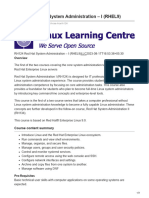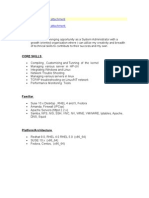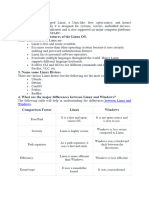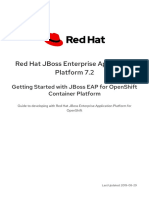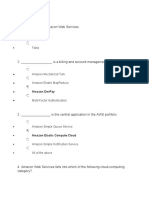RHCA Syllabus
RHCA Syllabus
Uploaded by
Challagolla GovardhanCopyright:
Available Formats
RHCA Syllabus
RHCA Syllabus
Uploaded by
Challagolla GovardhanOriginal Description:
Original Title
Copyright
Available Formats
Share this document
Did you find this document useful?
Is this content inappropriate?
Copyright:
Available Formats
RHCA Syllabus
RHCA Syllabus
Uploaded by
Challagolla GovardhanCopyright:
Available Formats
RHCA Syllabus / Course Outline
RH442 Red Hat Enterprise System Monitoring and Performance Tuning
Course Outline
Unit 1 - Elements of Monitoring and Tuning
Performance tuning is... Before you begin How much is how much? Calculating unit conversions Monitoring Monitoring vs. Profiling Whole-system view Sample application model Sample hardware model Before tuning the kernel Kernel tunables Using system documentation Recovering from problems
Unit 2 - Simple Network Monitoring
SNMP SNMP versions Management Information Base The MIB hierarchy Referring to MIB objects Reading a MIB file Installing SNMP packages Finding MIB objects Using SNMP v1 for queries Using SNMP v3 for queries Configuring the SNMP client ipsr solutions ltd
RHCA Course Syllabus
Enabling the SNMP agent Profiling SNMP host access controls Configuring SNMP v1 access Configuring SNMP v3 access Beyond RH442: Extending snmpd
Unit 3 - Graphical Reporting
MRTG Configuring MRTG Allowing access to MRTG Creating a dashboard in MRTG Ad-hoc utilities Installing iostat and sar Using iostat and sar Configuring sar Awk Using awk Gnuplot Using Gnuplot Creating a custom script Scheduling a custom script
Unit 4 - Kernel-Level Profiling
OProfile Installing OProfile Installing kernel-debuginfo Setting up OProfile Running a test Reviewing results OProfile architecture SystemTap Required packages SystemTap scripts The stap command
Unit 5 - Queuing Theory
Introduction to queuing theory Little's Law Queue length RHCA Course Syllabus ipsr solutions ltd
Queue length vs wait time Wait time A closer look at wait time How much user time is needed? Profiling time with time Finding hot spots in code Completion rate Arrival rate vs completion rate Finding a valid observation period Predicting system-wide limits Predicting resource limits Summary of strategies
Unit 6 - Compensating for Physical Disk Characteristics
Physical factors affect disk IO Disk storage density Choosing a peripheral interconnect SCSI bus considerations Electro-mechanical positioning Block IO requests and cache effect Tuning sequential read access Tuning the disk queue Tuning the deadline scheduler Tuning the anticipatory scheduler Tuning the noop scheduler Tuning the (default) cfq scheduler Fine-tuning the cfq scheduler Physical block device interfaces Virtual block devices Tuning virtual block devices Logical volumes and VBDs Implementing snapshot storage
Unit 7 - Reducing Disk Visit Count
The virtual file system (VFS) Layout of ext2/ext3 Fragmentation Viewing fragmentation Tuning fragmentation ipsr solutions ltd
RHCA Course Syllabus
Filesystem limits Journaling Improving journal performance Tuning journal placement Other mount-time options Finding lock contention Reducing visit count with RAID Calculating chunk size Calculating filesystem stride Tuning round-robin RAID Write overhead for RAID5 and RAID6 Improving RAID1 performance Tuning RAID1 Tuning RAID in SysFS
Unit 8 - Processes and the Scheduler
Characterizing process states Getting ready to run Types of CPU cache Locality of reference Improving locality of reference Multitasking and the run queue Preempting the current process Sorting the run queue SCHED_OTHER Tuning scheduler policy Viewing CPU performance data
Unit 9 - Kernel Timing and Process Latency
How Linux tracks time Tuning system ticks Tuning processor speed IRQ balancing Tuning IRQ affinity Equalizing CPU visit count Tuning process affinity with taskset Tuning run queue length with taskset Hot-plugging CPUs Scheduler domains ipsr solutions ltd
RHCA Course Syllabus
Configuring the root cpuset Configuring a child cpuset Important files for scheduler domains Virtual CPUs Tuning VCPUs at domain creation Tuning VCPUs dynamically Tuning VCPU affinity
Unit 10 - Memory Addressing and Allocation
Overview of memory addressing Virtual address space (32-bit) Viewing process address space Tuning process address space Physical address space Mapping virtual addresses (x86) Uniform memory architecture (x86) Overview of memory allocation Improving RAM performance Improving MMU performance Tuning the NUMA allocator Improving TLB performance Tuning TLB performance Viewing system calls Virtual domain memory Tuning memory at domain creation Tuning domain memory dynamically Recovering unassigned memory
Unit 11 - Memory Caches
Strategies for using memory A closer look at demand paging Tuning page allocation Tuning overcommit Slab cache ARP cache Tuning ARP cache Page cache Tuning page cache Anonymous pages ipsr solutions ltd
RHCA Course Syllabus
SysV IPC Tuning SysV IPC Viewing memory with free Other commands to view memory usage
Unit 12 - Memory Reclamation
Characterizing page status Calculating dirty and clean memory Reclaiming dirty pages Tuning pdflush Reclaiming clean pages Out-of-memory killer Tuning OOM policy Detecting memory leaks What is swap? Improving swap performance Tuning swappiness Tuning swap size Tuning swap for think time Tuning swap visit count Monitoring memory usage
Unit 13 - Essential Network Tuning
Simplified transmit model Simplified receive model Kernel socket buffers Calculating total buffer size Calculating per-socket buffer size Tuning core buffer size Tuning TCP buffer size Tuning DMA buffer size Is packet fragmentation a problem? Tuning fragmentation buffers Network interrupt handling Improving interrupt handling Tuning interrupt handling Network sockets TCP sockets Viewing network sockets ipsr solutions ltd
RHCA Course Syllabus
Tuning TCP socket creation Tuning TCP socket keepalive
RH436 Red Hat Enterprise Clustering and Storage Management
Course Outline Review Red Hat Enterprise Clustering and Storage Management Technologies Linux Dynamic Device Management udev Features udev Rule Configuration iSCSI iSCSI as a Shared Storage Device Configuring an iSCSI initiator Configuring an iSCSI target Authentication Advanced Software RAID Types and Differences Monitoring Optimization Techniques Growth and High Availability Device Mapper and Multipathing Mapping Targets LVM2 Snapshots Multipath Device Configuration Cluster Suite Overview Design and Elements of Clustering Cluster Configuration Tools Clustered Logical Volumes and Lock Management Quorum and the Cluster Manager Intracluster Communication Cluster Tools Fencing and Failover Fencing Components Failover Domains Quorum Disk Heuristic Configuration Service Manager Resource Groups and Recovery RHCA Course Syllabus ipsr solutions ltd
Hierarchical Resource Ordering High Availability Services Global File System (GFS) Implementation and Configuration Lock Management Planning For and Growing On-line GFS Monitoring Tools Journal Configuration and Management
RHS333 Red Hat Enterprise Security: Network Services
The Threat Model and Protection Methods Internet threat model and the attacker's plan System security and service availability An overview of protection mechanisms Basic Service Security SELinux Host-based access control Firewalls using Netfilter and iptables TCP wrappers xinetd and service limits Cryptography Overview of cryptographic techniques Management of SSL certificates Using GnuPG BIND and DNS Security BIND vulnerabilities DNS Security: attacks on DNS Access control lists Transaction signatures Restricting zone transfers and recursive queries DNS Topologies Bogus servers and blackholes Views Monitoring and logging Dynamic DNS security Network Authentication: RPC, NIS, and Kerberos Vulnerabilities RHCA Course Syllabus ipsr solutions ltd
Network-managed users and account management RPC and NIS security issues Improving NIS security Using Kerberos authentication Debugging Kerberized Services Kerberos Cross-Realm Trust Kerberos Encryption Network File System Overview of NFS versions 2, 3, and 4 Security in NFS versions 2 and 3 Improvements in security in NFS4 Troubleshooting NFS4 Client-side mount options OpenSSH Vulnerabilities Server configuration and the SSH protocols Authentication and access control Client-side security Protecting private keys Port-forwarding and X11-forwarding issues Electronic Mail with Sendmail Vulnerabilities Server topologies Email encryption Access control and STARTTLS Anti-spam mechanisms Postfix Vulnerabilities Security and Postfix design Anti-spam mechanisms Configuring SASL/TLS FTP Vulnerabilities The FTP protocol and FTP servers Logging Anonymous FTP Access control Apache security ipsr solutions ltd
RHCA Course Syllabus
Vulnerabilities Access control Authentication: files, passwords, Kerberos Security implications of common configuration options CGI security Server side includes suEXEC Intrusion Detection and Recovery Intrusion risks Security policy Detecting possible intrusions Monitoring network traffic and open ports Detecting modified files Investigating and verifying detected intrusions Recovering from, reporting, and documenting intrusions
RH401 Red Hat Enterprise Deployment and Systems Management Course Outline
Unit 1 - Essential System Management Goals of Enterprise system management Standardization, centralization, and scalability Provisioning and automation Unit 2 - Installing a Red Hat Network Satellite Server Introduction to RHN Satellite - features, prerequisites Installing Satellite Server software Understanding software channels and entitlements Importing channel content into a Satellite Server Unit 3 - Red Hat Network Organization Organization management and trust relationships Managing user accounts Assigning user roles (security) Managing system groups
Unit 4 - Managing Changes with Revision Control Introducing revision control concepts Basic Subversion repository administration RHCA Course Syllabus ipsr solutions ltd
Using Subversion to manage revisions Unit 5 - Red Hat Network Client Configuration Secure communication with SSL Red Hat Network registration Creating and using activation keys Registration automation with bootstrap.sh Troubleshooting RHN registration Unit 6 - Red Hat Network Software Management Software channel relationships Cloning existing software channels Managing custom software channels Notifying clients of changes: managing errata Unit 7 - Building RPMs Building open source software Using RPM macros Writing custom spec files Using rpmbuild to create RPMs Signing packages for security Unit 8 - RHN Application Programmer Interface Uses for Red Hat Network API Basic RHN API program structure Sample programs Unit 9 - Configuration File Management with Red Hat Network Managing configuration channels Configuration file macros Configuration file management using command-line tools Unit 10 - Provisioning with Kickstart Anaconda kickstart options Building a provisioning environment Using Cobbler for provisioning
Unit 11 - Virtual Machine Management RHCA Course Syllabus ipsr solutions ltd
Virtual host/virtual platform entitlements Controlling Xen guests using RHN Red Hat Network management of Xen virtual machines Unit 12 - RHN Satellite Server Administration High-availability options Embedded database management Certificate management Changing from disconnected to connected operation Inter-satellite synchronization (ISS) Exporting software channels Troubleshooting Unit 13 - Red Hat Network Proxy Server RHN proxy server installation Configuring a client to use a RHN proxy server Managing software with RHN package manager
RH423 Red Hat Enterprise Directory Services and Authentication
Course Outline Introduction to Directory Services What is a directory? LDAP: models, schema, and attributes Object classes LDIF The LDAP Naming Model Directory information trees and Distingued Names X.500 and "Internet" naming suffixes Planning the directory hierarchy Red Hat Directory Server: Basic Configuration Installation and setup of Red Hat Directory Server Using the Red Hat Console Using logging to monitor Red Hat Directory Server activity Backing up and restoring the directory Basic performance tuning with indexes Searching and Modifying the LDAP Directory Using command line utilities to search the directory RHCA Course Syllabus ipsr solutions ltd
Search filter syntax Updating the directory Red Hat Directory Server: Authentication and Security Configuring TLS security Using access control instructions (ACI's) ACI's and the Red Hat Console Linux User Authentication with NSS and PAM Understanding authentication and authorization Name service switch (NSS) Advanced pluggable authentication modules (PAM) configuration Centralized User Authentication with LDAP Central account management with LDAP Using migration scripts to migrate existing data into an LDAP server LDAP user authentication Kerberos and LDAP Introduction to Kerberos Configuring the Kerberos key distribution center (KDC) and clients Configuring LDAP to support Kerberos Directory Referrals and Replication Referrals and replication Single master configuration Multiple master configuration Planning for directory server availability Cross-Platform Centralized Identity Management Synchronizing Red Hat Directory Server with Active Directory Managing users with Winbind and LDAP Mapping attributes between Linux and Windows
RHCA Course Syllabus
ipsr solutions ltd
You might also like
- RH124 Red Hat System Administration I RHEL9Document3 pagesRH124 Red Hat System Administration I RHEL9ayoub.iservNo ratings yet
- ALX Back End StorageDocument56 pagesALX Back End StorageKaylo Panashe RusakanikoNo ratings yet
- ChangesDocument60 pagesChangesprasad6401No ratings yet
- Devops Assignment - AtmanaDocument3 pagesDevops Assignment - AtmanaYuvarajNo ratings yet
- Hpux Interview QuestionsDocument8 pagesHpux Interview QuestionsKuldeep Kushwaha100% (1)
- InfoBlox SNMP Enterprise MIBDocument20 pagesInfoBlox SNMP Enterprise MIBKali LNo ratings yet
- GET Training Contents - Phase IIIDocument14 pagesGET Training Contents - Phase IIImehukrNo ratings yet
- Linux Fresher CV FormatDocument4 pagesLinux Fresher CV FormatSachin Nakti100% (3)
- Book Autoyast PDFDocument252 pagesBook Autoyast PDFel-sOdANo ratings yet
- RH442 Red Hat Enterprise System Monitoring and Performance TuningDocument2 pagesRH442 Red Hat Enterprise System Monitoring and Performance TuningAlex Skolnick0% (1)
- MOP For ASR903 OS UpgradeDocument6 pagesMOP For ASR903 OS UpgradeHaseeb MubarikNo ratings yet
- Real-Time Linux BasicsDocument4 pagesReal-Time Linux Basicsh.kev07No ratings yet
- Solaris 10 Installation Guide - Solaris Flash Archives (Creation and Installation)Document86 pagesSolaris 10 Installation Guide - Solaris Flash Archives (Creation and Installation)subhankar5455No ratings yet
- Troubleshooting: 7.1. Unable To See Files On A Mounted File SystemDocument4 pagesTroubleshooting: 7.1. Unable To See Files On A Mounted File Systemrich garciaNo ratings yet
- Linux Interview QuestionsDocument18 pagesLinux Interview QuestionsBharathNo ratings yet
- Red Hat Enterprise Linux-7-Performance Tuning Guide-En-USDocument82 pagesRed Hat Enterprise Linux-7-Performance Tuning Guide-En-USBryan BowmanNo ratings yet
- Setting Up Squid Proxy ServerDocument22 pagesSetting Up Squid Proxy ServerRamesh Kumar VaradharajanNo ratings yet
- The Ultimate Veritas Cluster Server (VCS) Interview Questions PDFDocument21 pagesThe Ultimate Veritas Cluster Server (VCS) Interview Questions PDFnavin_netNo ratings yet
- Extending and Multi Rack Cabling Guide Engineered Systems DBMMRDocument212 pagesExtending and Multi Rack Cabling Guide Engineered Systems DBMMRfeliugarciaNo ratings yet
- Suse Manager InstallDocument162 pagesSuse Manager InstallFabian Quevedo CoronaNo ratings yet
- 6-68046-01 SN 5 TuningGuide RevDocument118 pages6-68046-01 SN 5 TuningGuide RevAvl SubbaraoNo ratings yet
- Practical Training Report: LinuxDocument31 pagesPractical Training Report: LinuxRohit ShekhawatNo ratings yet
- Red Hat Enterprise Linux 6 Deployment Guide en USDocument735 pagesRed Hat Enterprise Linux 6 Deployment Guide en USAmr El-Ganzory100% (1)
- SLE321 High Availability Clustering With SUSE Linux Enterprise 12Document2 pagesSLE321 High Availability Clustering With SUSE Linux Enterprise 12otra dosNo ratings yet
- Unix Full NotesDocument52 pagesUnix Full NotesRahul SinhaNo ratings yet
- Lame - Linux Administration For BeginnersDocument85 pagesLame - Linux Administration For Beginnersskolliboina100% (4)
- RHLS User Guidelines PDFDocument50 pagesRHLS User Guidelines PDFAbhishekNo ratings yet
- Configure High Availability Cluster in Centos 7 (Step by Step Guide)Document9 pagesConfigure High Availability Cluster in Centos 7 (Step by Step Guide)HamzaKhanNo ratings yet
- Interview Questions and AnswersNFSDocument3 pagesInterview Questions and AnswersNFSRaja SubramanianNo ratings yet
- Red Hat Enterprise Linux-6-Storage Administration Guide-En-USDocument209 pagesRed Hat Enterprise Linux-6-Storage Administration Guide-En-UScresmakNo ratings yet
- LP Lecture NotesDocument193 pagesLP Lecture Notesvahini SNo ratings yet
- FDIO Quick Start Guide PDFDocument22 pagesFDIO Quick Start Guide PDFPraveen KumarNo ratings yet
- Basic Linux ArchitectureDocument11 pagesBasic Linux ArchitectureJyothy LakshuNo ratings yet
- Linux File System - Ext2 Vs Ext3 Vs Ext4 Vs XFSDocument2 pagesLinux File System - Ext2 Vs Ext3 Vs Ext4 Vs XFSridteamNo ratings yet
- Red Hat JBoss Enterprise Application Platform-7.2-Getting Started With JBoss EAP For OpenShift Container Platform-En-USDocument66 pagesRed Hat JBoss Enterprise Application Platform-7.2-Getting Started With JBoss EAP For OpenShift Container Platform-En-USEdgar Orlando Bermudez AljuriNo ratings yet
- How To Extend-Reduce LVMDocument29 pagesHow To Extend-Reduce LVMMazanaNo ratings yet
- Artifactory-Configuring With JenkinsDocument9 pagesArtifactory-Configuring With Jenkinskhursheed4u3590No ratings yet
- Linux ProgramDocument22 pagesLinux Programjurgis_gregovNo ratings yet
- AWS Administrator MCQDocument12 pagesAWS Administrator MCQsachin shettyNo ratings yet
- Rhce ExamsDocument8 pagesRhce Examsme_existenceNo ratings yet
- Using A Staging Table For Efficient MySQL Data Warehouse IngestionDocument6 pagesUsing A Staging Table For Efficient MySQL Data Warehouse IngestionDany BalianNo ratings yet
- What Is RundeckDocument3 pagesWhat Is Rundeckjoe_netNo ratings yet
- Linux Admin IIIDocument230 pagesLinux Admin IIIUncleSam100% (4)
- GPFS Configuration and TuningDocument270 pagesGPFS Configuration and TuningLakhbir DhillonNo ratings yet
- Dileep Kumar: #1: Encrypt Data CommunicationDocument8 pagesDileep Kumar: #1: Encrypt Data Communicationkumar184No ratings yet
- Unix Utilities: Grep, Sed, and AwkDocument81 pagesUnix Utilities: Grep, Sed, and Awkseburkhardt100% (1)
- UNIX Shell ScriptingDocument25 pagesUNIX Shell ScriptingsatiurNo ratings yet
- Syslog-Ng Guide HPUXDocument7 pagesSyslog-Ng Guide HPUXDenilson NascimentoNo ratings yet
- Time Series DatabaseDocument6 pagesTime Series DatabaseMR. SURIYA PRAKASHNo ratings yet
- Oracle Solaris 11 System Virtualization Complete Self-Assessment GuideFrom EverandOracle Solaris 11 System Virtualization Complete Self-Assessment GuideNo ratings yet
- Practical LPIC-3 300: Prepare for the Highest Level Professional Linux CertificationFrom EverandPractical LPIC-3 300: Prepare for the Highest Level Professional Linux CertificationNo ratings yet
- Practical Ansible: Learn how to automate infrastructure, manage configuration, and deploy applicationsFrom EverandPractical Ansible: Learn how to automate infrastructure, manage configuration, and deploy applicationsNo ratings yet
